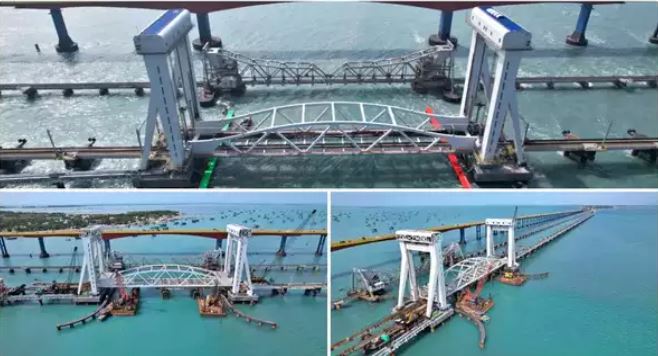History of the Pamban Bridge
New Delhi: On the occasion of Ram Navami, Prime Minister Narendra Modi inaugurated India’s inaugural vertical lift sea bridge, the New Pamban Bridge, located in Ramanathapuram, Tamil Nadu, this Sunday. According to a statement from the Ministry of Railways, the 2.07-kilometre-long New Pamban Bridge, which crosses the Palk Strait, exemplifies India’s engineering capabilities and forward-thinking infrastructure initiatives.
The bridge features a vertical lift that spans 72.5 metres and accommodates two tracks. Its approach consists of 88 spans made of 18.3-metre steel plate girders designed for a single line.
The history of the bridge dates back to 1914, when British engineers built the original Pamban bridge. This structure was a cantilever design with a Scherzer Rolling Lift span, linking Rameswaram Island to the Indian mainland. The new bridge, approved in 2019, is elevated by 3 meters compared to its predecessor, enhancing maritime connectivity.
This bridge has been crucial for pilgrims, tourists, and trade. However, the challenging marine conditions and increasing transportation needs prompted the need for a modern solution. The Ministry’s statement noted that in 2019, the Central government approved the construction of a technologically advanced and future-ready replacement.
New Pamban Bridge was built by Rail Vikas Nigam Limited (RVNL)
The New Pamban Bridge was built by Rail Vikas Nigam Limited (RVNL), a Navratna Public Sector Undertaking under the Ministry of Railways. RVNL has ensured that the bridge complies with elevated standards for speed, load capacity, and maritime specifications. This new structure not only improves connectivity but also highlights India’s capabilities in infrastructure regarding safety, durability, and innovation. According to the ministry, the bridge features stainless steel reinforcement, high-quality protective paint, and fully welded joints. A specialized polysiloxane coating has been applied to guard against corrosion, ensuring its longevity in a challenging marine environment. By the early 21st century, the previous bridge was inadequate for contemporary transportation needs. The rising traffic volume and the demand for quicker, safer connections led the government to plan for a new, technologically advanced, and durable structure. The aim was to construct a modern sea bridge capable of handling increased traffic, ensuring resilience, and facilitating smoother maritime navigation.
Regional connectivity and promoting economic development,
The New Pamban Bridge was designed to overcome the shortcomings of its predecessor while enhancing regional connectivity and promoting economic development, as stated. The original bridge, built in 1914, played a crucial role in trade and pilgrimage but could no longer satisfy the requirements of modern rail transport. Given the area’s seismic risks, cyclones, and marine corrosion, a robust and technologically sophisticated replacement was deemed necessary, according to the ministry. The construction of the new Pamban Bridge faced various challenges, including environmental hurdles and logistical issues. The turbulent waters of the Palk Strait, along with strong winds and unpredictable weather, complicated the construction efforts. Furthermore, the region’s vulnerability to cyclones and seismic events required meticulous planning and a strong design approach.




